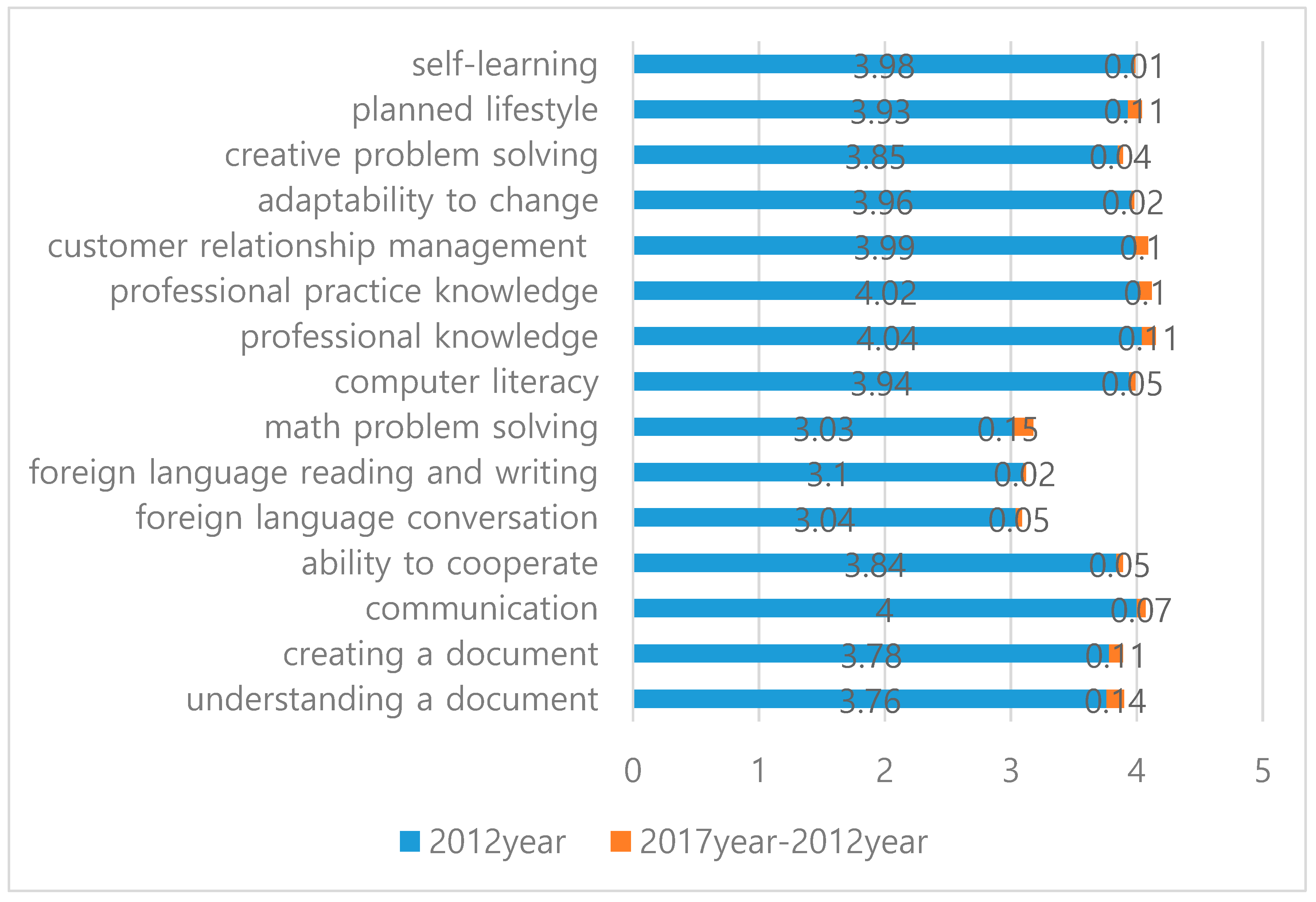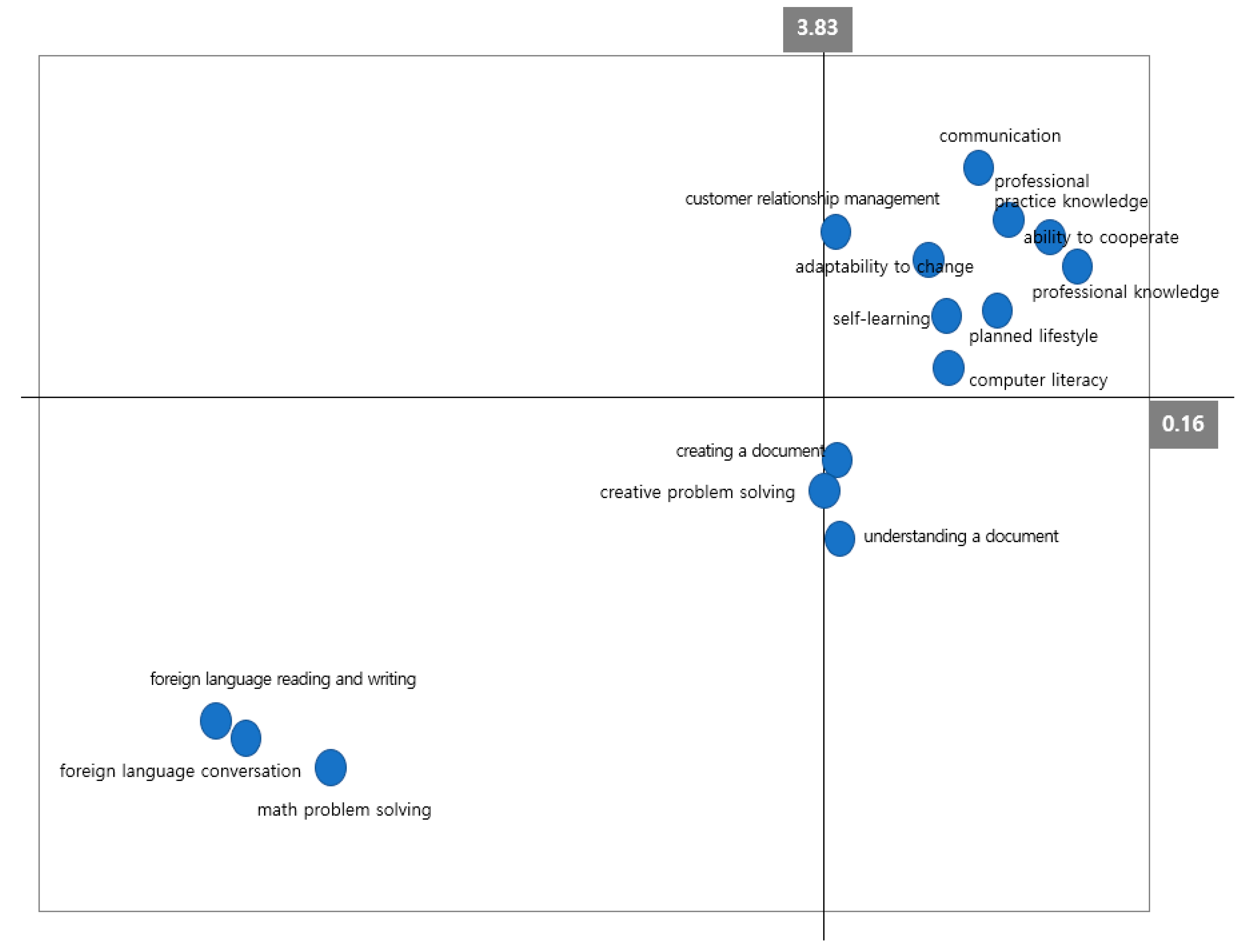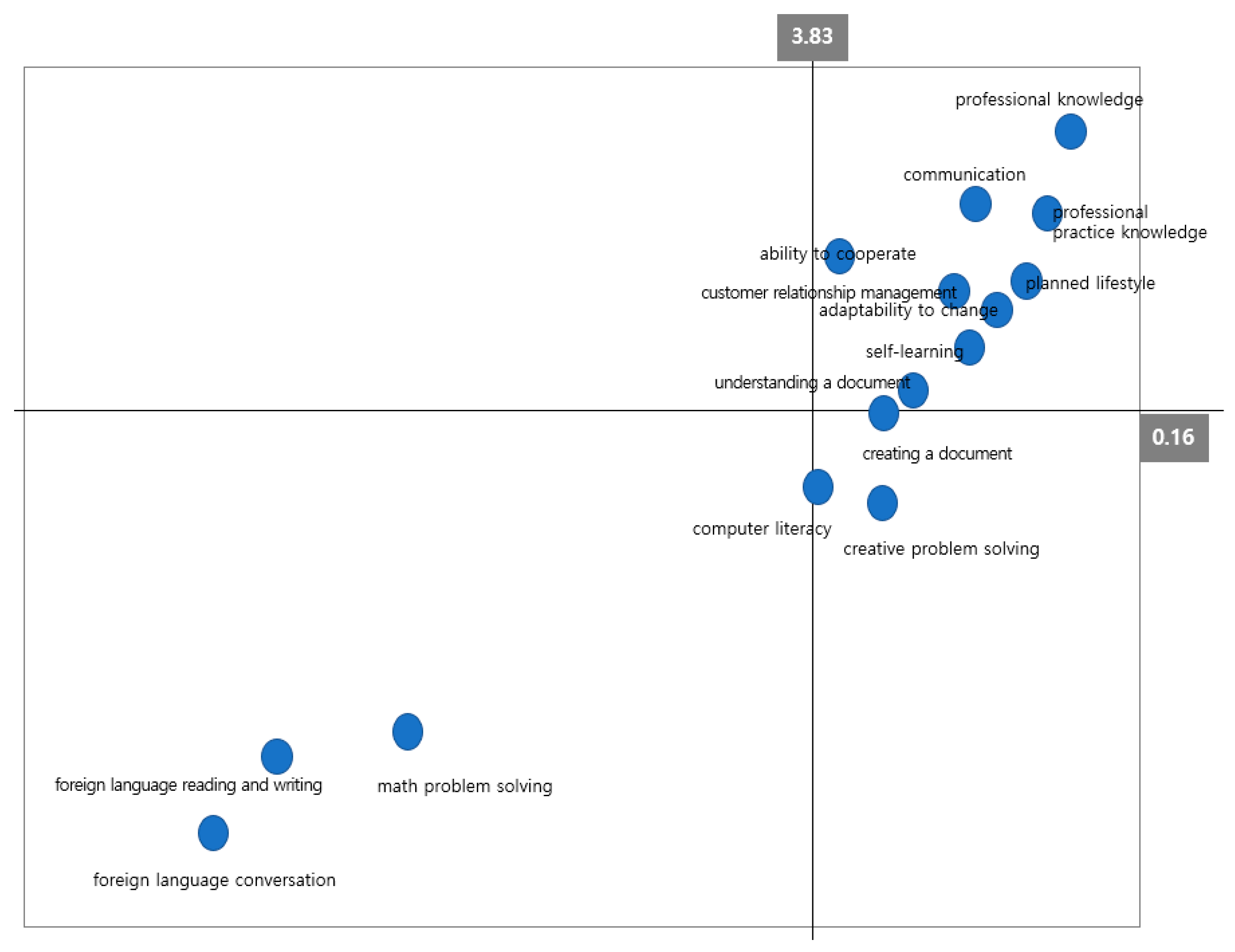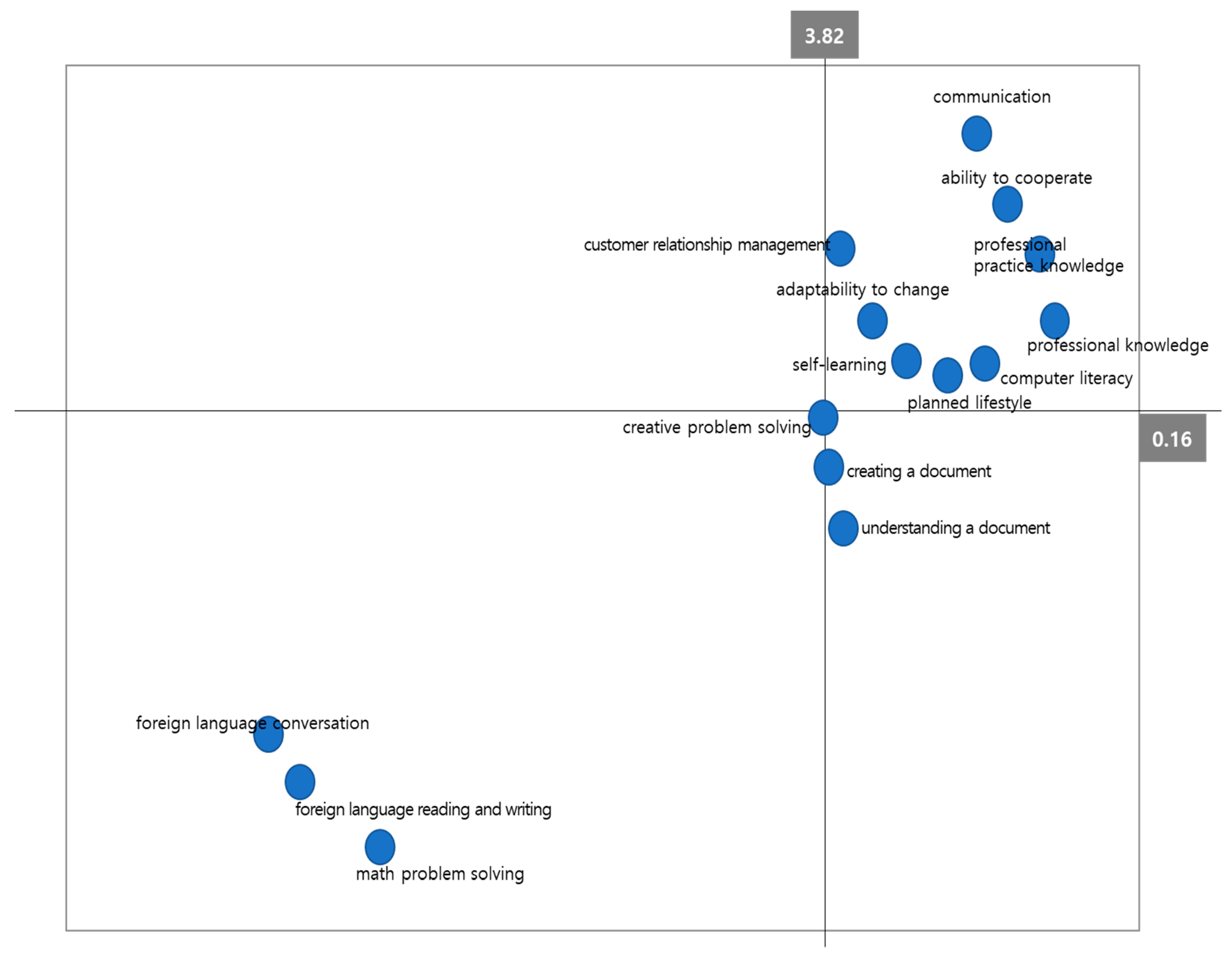Analysis of the Educational Needs Related to, and Perceptions of the Importance of, Essential Job Competencies among Science and Engineering Graduates
Abstract
1. Introduction
2. Theoretical Background
2.1. Essential Job Competencies
2.2. Prior Studies
3. Materials and Methods
3.1. Participants
3.2. Instruments
3.3. Data Analysis
4. Results
4.1. Analysis of Differences in Perceptions of the Importance of Essential Job Competencies among Science and Engineering Graduates
4.2. Analysis of the Educational Needs Related to Essential Job Competencies Based on the Responses of Science and Engineering Graduates
4.2.1. Paired T-Test and Borich Needs Assessment of Essential Job Competencies Based on the Responses of Science and Engineering Graduates
4.2.2. Locus for Focus Analysis of the Essential Job Competencies of Science and Engineering Graduates
4.3. Analysis of Differences in Perceptions of the Educational Needs Related to Essential Job Competencies by Department
4.3.1. Analysis of the Educational Needs Related to Basic Essential Job Competencies Among Science Graduates.
4.3.2. Analysis of the Educational Needs Related to Essential Job Competencies Among Engineering Graduates
5. Conclusions and Discussion
Author Contributions
Funding
Conflicts of Interest
References
- Chosun Edu. Available online: http://edu.chosun.com/site/data/html_dir/2018/04/12/2018041201316.html (accessed on 2 January 2020).
- Joo, I.J.; Cho, J.Y.; Lim, G.B. Current Issues and Policy Strategies of NSC Projects. Hrd. Rev. 2010, 13, 19–39. [Google Scholar]
- Na, S.I.; Cho, J.Y.; Uh, S.B.; Jang, H.J.; Sung, H.J. The Strategies for the New Installation of a National Certificate on the Basic Competencies. Agric. Educ. Hum. Resour. Dev. 2012, 44, 131–160. [Google Scholar]
- Ju, I.J.; Jin, M.S.; Park, D.Y. The Study of Core Competency’s Domains and Levels; Korea Research Institute for Vocational Education & Training: Seoul, Korea, 2010. [Google Scholar]
- Song, B.G. How to improve the job essential competencies in school education. Soonchunhyang J. Humanit. 2000, 9, 45–72. [Google Scholar]
- Yoon, D.W. A Study on the Effects of Key Competencies on Skill: A Focus on College Graduate Newcomers in Large Corporation; Doctorate-KOREATECH: Cheonan, Korea, 2018. [Google Scholar]
- Seo, B.K.; Moon, J.S. Review of Korean NCS Research Trends and Suggestions for Future Research Directions. J. Vocat. Educ. Train. 2018, 21, 1–29. [Google Scholar]
- Human Resources Development Service of Korea. Manual of NCS Development; HRDK: Seoul, Korea, 2016; pp. 1–128. [Google Scholar]
- Human Resources Development Service of Korea. Manual of NCS Corporate Application Consulting; HRDK: Seoul, Korea, 2017; pp. 1–148. [Google Scholar]
- Lee, G.N.; Jyong, C.Y. Analysis on the Key Competencies of Students and Related Program Recognized by Teachers in Vocational High School. Agric. Educ. Hum. Resour. Dev. 2003, 35, 47–68. [Google Scholar]
- Woo, S.H.; Lim, H.K.; Kim, J.S. Key Competencies Level of Students Recognized by Specialized Subjects Teachers in Industrial High School. J. Vocat. Educ. Res. 2005, 24, 69–98. [Google Scholar]
- An, G.S. A Study on Level and Significance of Key Competencies perceived by Technical High school Teacher. J. Korean Pract. Arts Educ. 2007, 13, 73–94. [Google Scholar]
- An, G.S.; Choi, W.S.; Lee, Y.M. A Study on degree of the Educational need for the Key Competencies of Technical high school students perceived by Teacher. Korean J. Technol. Educ. 2007, 7, 31–47. [Google Scholar]
- Bae, G.M.; Yoon, G.S. Training needs analysis for the development of basic job skill curriculum in specialized high school. Korean Inst. Ind. Educ. 2015, 40, 44–71. [Google Scholar]
- An, G.S.; Kim, M.K.; Choi, W.S. A study on the key competencies of college students, Journal of Korean Institute of Industrial Educators. Korean J. Inst. Ind. Educ. 2005, 30, 96–105. [Google Scholar]
- Hong, A.J.; Cho, Y.S.; Park, C.G. Exploration of college students’ characteristics on NCS basic vocational competencies. Study Educ. 2015, 53, 389–417. [Google Scholar]
- Lee, W.J.; Han, J.Y. An Importance Analysis of Basic Vocational Competencies for Developing and Implementing Secretarial Training Programs based on NCS. Women’s Stud. 2015, 89, 119–154. [Google Scholar]
- Lee, J.W.; Kim, J.M. Importance-Performance Analysis on University Students’ Recognition of NCS Vocational Competency. J. Vocat. Educ. Res. 2016, 35, 75–96. [Google Scholar]
- Lee, C.; Jung, D.Y.; Jung, B.Y.; Kwak, M.S. Development a Model for Basic Competencies of Secondary Level Vocational Education. J. Vocat. Educ. Res. 2015, 34, 125–148. [Google Scholar]
- Park, D.Y.; Hwang, Y.A. Development of the Test Based on BARS to Measure Core Competency Level for Vocational High School Students. Korean Soc. Agric. Educ. Hum. Resour. Dev. 2009, 41, 29–48. [Google Scholar]
- Cho, H.Y. The Relationships between Vocational Key Competencies and Sub-Competencies of College Students—A Case of K College. Korean J. Gen. Educ. 2017, 11, 333–362. [Google Scholar]
- Baik, J.M.; Park, Y.K. An Exploring Study on the Possibility of Utilizing the NCS (National Competency Standard) for University Education. J. Employ. Career 2012, 2, 1–19. [Google Scholar]
- Chosun Edu. Available online: http://edu.chosun.com/site/data/html_dir/2018/04/26/2018042601182.html (accessed on 2 January 2020).
- Ennis, M.R.; Employment and Training Administration; United States, and Office of Policy Development and Research. Competency Models: A Review of the Literature and the Role of the Employment and Training Administration (ETA); Office of Policy Development and Research, Employment and Training Administration, U.S. Dept. of Labor: Washington, DC, USA, 2008; pp. 1–24.
- McClelland, D.C. Testing for competence rather than for “intelligence”. Am. Psychol 1973, 28, 1–14. [Google Scholar] [CrossRef]
- Boyatzis, R.E. Competence and Job Performance. In The Competent Manager: A Model for Effective Performance; Wiley: New York, NY, USA, 1982; pp. 10–39. [Google Scholar]
- Lim, E.; Choi, D.S.; Choi, J.H.; Oh, E.J. Survey on Adults’ Key Competences: OECD ALL Survey; Korea Research Institute for Vocational Education & Training: Seoul, Korea, 2004; pp. 1–283. [Google Scholar]
- Park, J.H.; Lee, J.P.; Park, Y.H. Analysis of Educational Needs of Industry on Essential Job Competency of Graduates from Korea Polytechnics. J. Vocat. Educ. Res. 2013, 32, 83–105. [Google Scholar]
- Kim, M.H.; Lee, J.G. A Structural Relationship among Self-Perceived Occupational Basic Competencies, Career Decision Level, Job Searching Efficacy, and Career Preparation Behavior of Junior College Students. J. Vocat. Educ. Res. 2018, 30, 111–127. [Google Scholar]
- Kim, S.H. A Study on the Needs Assessment of key Competencies from Industries of College Graduates. In Proceedings of the 2014 Fall Conference, Daejeon, Korea, 28 November 2014; Korea Academia-Industrial Cooperation Society: Cheonan, Korea, 2014. [Google Scholar]
- Hwang, Y.H.; Park, S.J. Educational needs analysis for key vocational competency in nursing students. J. Korea Acad. -Ind. Coop. Soc. 2016, 17, 595–603. [Google Scholar]
- OECD. PISA 2012 Assessment and Analytic Framework; OECD: Paris, France, 2013; pp. 1–265. [Google Scholar]
- OECD. DeSeCo. Excutive Summary; OECD: Paris, France, 2005; pp. 1–20. [Google Scholar]
- National Academy of Engineering. The engineer of 2020: Visions of Engineering in the New Century; National Academies Press: Washington, DC, USA, 2004; pp. 1–101. [Google Scholar]
- Kessler, S. GIGGED: The End of the Job and the Future of Work; St. Martin’s Press: New York, UK, USA, 2018; pp. 1–304. [Google Scholar]
- KEEN’zine. ISSUE 4. Available online: https://engineeringunleashed.com/resources/keenzine.aspx (accessed on 7 March 2020).
- Frey, C.B.; Osborne, M.A. The future of employment: How susceptible are jobs to computerisation? Technol. Forecast. Soc. Chang. 2017, 114, 254–280. [Google Scholar] [CrossRef]
- OECD. Technical Report of the Survey of Adult Skills (PIAAC); OECD: Paris, France, 2013; pp. 1–1033. [Google Scholar]




| Authors | 1 | 2 | 3 | 4 | 5 | 6 | 7 | 8 | 9 | 10 | 11 | 12 | |
|---|---|---|---|---|---|---|---|---|---|---|---|---|---|
| Jung et al. (2000) | ○ | ○ | ○ | ○ | ○ | ○ | ○ | ○ | ○ | ||||
| Lee et al. (2000) | ○ | ○ | ○ | ○ | ○ | ○ | ○ | ○ | ○ | ○ | |||
| Na et al. (2003) | ○ | ○ | ○ | ○ | ○ | ○ | ○ | ○ | ○ | Vocational Ethics | |||
| Jin et al. (2007,2009) | ○ | ○ (Processing and use of resource information technology) | ○ | ○ | ○ | Global Perspective | |||||||
| Lee et al. (2008) | ○ | ○ | ○ | ○ | ○ | ○ | ○ | ○ | ○ | ○ | Change Management | ||
| Joo et al. (2010) | ○ | ○ | ○ | ○ | ○ | ○ | ○ | ○ | ○ | ||||
| Personal Variables | Frequency | % | Personal Variables | Frequency | % | ||
|---|---|---|---|---|---|---|---|
| Gender | Male | 410 | 68.9 | Major | Science | 164 | 27.6 |
| Female | 185 | 31.1 | Engineering | 431 | 72.4 | ||
| Age | Under 30 | 169 | 28.4 | Level of Education | College Graduates | 160 | 26.9 |
| 30-34 | 288 | 48.4 | University Graduates | 386 | 64.9 | ||
| 35-39 | 138 | 23.2 | Master’s and Above | 49 | 8.2 | ||
| Total | 595 | 100.0 | Total | 595 | 100.0 | ||
| Division | Details | Remarks |
|---|---|---|
| Measurement | 2012 (7th Year), 2017 (11th Year) | Comparison over 5 Years |
| Essential Job Competencies (Job Performance) | 1. Understanding a document, 2. Creating a document, 3. Communication, 4. Customer relationship management, 5. Foreign language conversation, 6. Foreign language reading and writing, 7. Math problem solving, 8. Computer literacy, 9. Professional knowledge, 10. Professional practice knowledge, 11. Ability to cooperate, 12. Adaptability to change, 13. Creative problem solving, 14. Planned lifestyle, 15. Self-learning | 15 Items |
| Importance of Job Competencies | Very unimportant, Unimportant, Neutral, Important, Very Important | 5-Point Scale |
| Contribution of the Final School | Very unhelpful, Unhelpful, Neutral, Somewhat helpful, Greatly helpful | 5-Point Scale |
| No. | Variable | N | 2012 | 2017 | Differences | |||||
|---|---|---|---|---|---|---|---|---|---|---|
| Mean | SD | Order | Mean | SD | Order | Difference (Means) | Order | |||
| 1 | Understanding a Document | 595 | 3.76 | 0.846 | 12 | 3.90 | 0.885 | 9 | −0.139 | 2 |
| 2 | Creating a Document | 595 | 3.78 | 0.851 | 11 | 3.89 | 0.891 | 12 | −0.108 | 4 |
| 3 | Communication | 595 | 4.00 | 0.739 | 3 | 4.07 | 0.796 | 4 | −0.066 | 8 |
| 4 | Customer Relationship Management | 595 | 3.84 | 0.844 | 10 | 3.89 | 0.850 | 11 | −0.050 | 10 |
| 5 | Foreign Language Conversation | 595 | 3.04 | 0.917 | 14 | 3.09 | 0.985 | 15 | −0.054 | 9 |
| 6 | Foreign Language Reading and Writing | 595 | 3.10 | 0.920 | 13 | 3.12 | 1.001 | 14 | −0.018 | 13 |
| 7 | Math Problem Solving | 595 | 3.03 | 0.945 | 15 | 3.18 | 1.027 | 13 | −0.148 | 1 |
| 8 | Computer Literacy | 595 | 3.94 | 0.882 | 7 | 3.99 | 0.936 | 7 | −0.044 | 11 |
| 9 | Professional Knowledge | 595 | 4.04 | 0.812 | 1 | 4.15 | 0.796 | 1 | −0.108 | 3 |
| 10 | Professional Practice Knowledge | 595 | 4.02 | 0.834 | 2 | 4.12 | 0.779 | 2 | −0.101 | 6 |
| 11 | Ability to Cooperate | 595 | 3.99 | 0.718 | 4 | 4.09 | 0.697 | 3 | −0.101 | 7 |
| 12 | Adaptability to Change | 595 | 3.96 | 0.660 | 6 | 3.98 | 0.744 | 8 | −0.018 | 14 |
| 13 | Creative Problem-Solving | 595 | 3.85 | 0.737 | 9 | 3.89 | 0.735 | 10 | −0.044 | 12 |
| 14 | Planned Lifestyle | 595 | 3.93 | 0.695 | 8 | 4.04 | 0.689 | 5 | −0.106 | 5 |
| 15 | Self-Learning | 595 | 3.98 | 0.655 | 5 | 3.99 | 0.697 | 6 | −0.013 | 15 |
| Variables | N | Contribution of the Final School | Importance | Difference (Means) | t | Borich Needs | Order of Priority | ||
|---|---|---|---|---|---|---|---|---|---|
| M | S.D. | M | S.D. | ||||||
| Understanding a Document | 595 | 3.78 | 0.766 | 3.90 | 0.885 | −0.119 | −3.646*** | 0.465 | 12 |
| Creating a Document | 595 | 3.75 | 0.787 | 3.89 | 0.891 | −0.138 | −4.233*** | 0.536 | 11 |
| Communication | 595 | 3.72 | 0.770 | 4.07 | 0.796 | −0.346 | −9.126*** | 1.408 | 1 |
| Customer Relationship Management | 595 | 3.61 | 0.816 | 3.89 | 0.850 | −0.284 | −7.356*** | 1.106 | 4 |
| Foreign Language Conversation | 595 | 3.18 | 0.898 | 3.09 | 0.985 | 0.089 | 2.535** | −0.276 | 13 |
| Foreign Language Reading and Writing | 595 | 3.21 | 0.912 | 3.12 | 1.001 | 0.092 | 2.946** | −0.288 | 14 |
| Math Problem Solving | 595 | 3.29 | 0.911 | 3.18 | 1.027 | 0.109 | 3.323** | −0.347 | 15 |
| Computer Literacy | 595 | 3.81 | 0.806 | 3.99 | 0.936 | −0.173 | −5.063*** | 0.690 | 9 |
| Professional Knowledge | 595 | 3.88 | 0.842 | 4.15 | 0.796 | −0.262 | −8.157*** | 1.087 | 5 |
| Professional Practice Knowledge | 595 | 3.84 | 0.847 | 4.12 | 0.779 | −0.284 | −8.651*** | 1.171 | 3 |
| Ability to Cooperate | 595 | 3.80 | 0.770 | 4.09 | 0.697 | −0.291 | −8.701*** | 1.190 | 2 |
| Adaptability to Change | 595 | 3.75 | 0.762 | 3.98 | 0.744 | −0.227 | −7.355*** | 0.903 | 6 |
| Creative Problem-Solving | 595 | 3.75 | 0.770 | 3.89 | 0.735 | −0.145 | −4.649*** | 0.563 | 10 |
| Planned Lifestyle | 595 | 3.83 | 0.725 | 4.04 | 0.689 | −0.205 | −6.890*** | 0.827 | 7 |
| Self-Learning | 595 | 3.79 | 0.714 | 3.99 | 0.697 | −0.202 | −6.925*** | 0.805 | 8 |
| Variables | N | Contribution of the Final School | Importance | Difference (Means) | t | Borich Needs | Order of Priority | ||
|---|---|---|---|---|---|---|---|---|---|
| M | S.D. | M | S.D. | ||||||
| Understanding a Document | 164 | 3.77 | 0.703 | 3.95 | 0.853 | −0.171 | −2.775** | 0.674 | 9 |
| Creating a Document | 164 | 3.76 | 0.798 | 3.92 | 0.879 | −0.159 | −2.257* | 0.622 | 10 |
| Communication | 164 | 3.77 | 0.748 | 4.09 | 0.786 | −0.317 | −4.184*** | 1.295 | 2 |
| Customer Relationship Management | 164 | 3.64 | 0.828 | 3.91 | 0.875 | −0.274 | −3.375*** | 1.074 | 4 |
| Foreign Language Conversation | 164 | 3.09 | 0.899 | 2.95 | 1.008 | 0.140 | 1.983** | −0.414 | 15 |
| Foreign Language Reading and Writing | 164 | 3.10 | 0.922 | 2.99 | 0.984 | 0.110 | 1.711 | −0.328 | 14 |
| Math Problem Solving | 164 | 3.20 | 0.866 | 3.10 | 1.037 | 0.098 | 1.356 | −0.303 | 13 |
| Computer Literacy | 164 | 3.75 | 0.802 | 3.88 | 0.971 | −0.128 | −1.675 | 0.497 | 11 |
| Professional Knowledge | 164 | 3.86 | 0.892 | 4.21 | 0.789 | −0.354 | −5.856*** | 1.490 | 1 |
| Professional Practice Knowledge | 164 | 3.85 | 0.853 | 4.16 | 0.754 | −0.311 | −5.106*** | 1.295 | 3 |
| Ability to Cooperate | 164 | 3.85 | 0.745 | 4.09 | 0.663 | −0.238 | −3.933*** | 0.973 | 7 |
| Adaptability to Change | 164 | 3.80 | 0.736 | 4.04 | 0.746 | −0.244 | −3.983*** | 0.986 | 6 |
| Creative Problem-Solving | 164 | 3.80 | 0.758 | 3.93 | 0.661 | −0.122 | −2.040* | 0.479 | 12 |
| Planned Lifestyle | 164 | 3.87 | 0.696 | 4.12 | 0.659 | −0.250 | −4.860*** | 1.029 | 5 |
| Self-Learning | 164 | 3.82 | 0.734 | 4.04 | 0.695 | −0.220 | −4.169*** | 0.887 | 8 |
| Variables | N | Contribution of the Final School | Importance | Difference (Means) | t | Borich Needs | Order of Priority | ||
|---|---|---|---|---|---|---|---|---|---|
| M | S.D. | M | S.D. | ||||||
| Understanding a Document | 431 | 3.78 | 0.790 | 3.88 | 0.897 | −0.100 | −2.582** | 0.387 | 12 |
| Creating a Document | 431 | 3.74 | 0.783 | 3.87 | 0.896 | −0.130 | −3.590*** | 0.503 | 11 |
| Communication | 431 | 3.70 | 0.778 | 4.06 | 0.801 | −0.357 | −8.164*** | 1.450 | 1 |
| Customer Relationship Management | 431 | 3.60 | 0.812 | 3.88 | 0.841 | −0.288 | −6.617*** | 1.117 | 4 |
| Foreign Language Conversation | 431 | 3.22 | 0.896 | 3.15 | 0.972 | 0.070 | 1.725* | −0.219 | 13 |
| Foreign Language Reading and Writing | 431 | 3.25 | 0.906 | 3.16 | 1.004 | 0.086 | 2.396** | −0.272 | 14 |
| Math Problem Solving | 431 | 3.32 | 0.927 | 3.20 | 1.023 | 0.114 | 3.137*** | −0.364 | 15 |
| Computer Literacy | 431 | 3.84 | 0.808 | 4.03 | 0.920 | −0.190 | −5.115*** | 0.766 | 8 |
| Professional Knowledge | 431 | 3.89 | 0.823 | 4.12 | 0.798 | −0.227 | −6.005*** | 0.937 | 5 |
| Professional Practice Knowledge | 431 | 3.83 | 0.846 | 4.11 | 0.788 | −0.274 | −7.022*** | 1.124 | 3 |
| Ability to Cooperate | 431 | 3.78 | 0.779 | 4.10 | 0.711 | −0.311 | −7.775*** | 1.273 | 2 |
| Adaptability to Change | 431 | 3.73 | 0.772 | 3.95 | 0.743 | −0.220 | −6.176*** | 0.871 | 6 |
| Creative Problem-Solving | 431 | 3.73 | 0.774 | 3.88 | 0.762 | −0.153 | −4.204*** | 0.594 | 10 |
| Planned Lifestyle | 431 | 3.82 | 0.735 | 4.00 | 0.699 | −0.188 | −5.203*** | 0.753 | 9 |
| Self-Learning | 431 | 3.78 | 0.706 | 3.97 | 0.698 | −0.195 | −5.586*** | 0.774 | 7 |
© 2020 by the authors. Licensee MDPI, Basel, Switzerland. This article is an open access article distributed under the terms and conditions of the Creative Commons Attribution (CC BY) license (http://creativecommons.org/licenses/by/4.0/).
Share and Cite
Lim, J.; Yoon, J.; Kim, M. Analysis of the Educational Needs Related to, and Perceptions of the Importance of, Essential Job Competencies among Science and Engineering Graduates. Educ. Sci. 2020, 10, 85. https://doi.org/10.3390/educsci10040085
Lim J, Yoon J, Kim M. Analysis of the Educational Needs Related to, and Perceptions of the Importance of, Essential Job Competencies among Science and Engineering Graduates. Education Sciences. 2020; 10(4):85. https://doi.org/10.3390/educsci10040085
Chicago/Turabian StyleLim, Jungyon, Jiyoung Yoon, and Misun Kim. 2020. "Analysis of the Educational Needs Related to, and Perceptions of the Importance of, Essential Job Competencies among Science and Engineering Graduates" Education Sciences 10, no. 4: 85. https://doi.org/10.3390/educsci10040085
APA StyleLim, J., Yoon, J., & Kim, M. (2020). Analysis of the Educational Needs Related to, and Perceptions of the Importance of, Essential Job Competencies among Science and Engineering Graduates. Education Sciences, 10(4), 85. https://doi.org/10.3390/educsci10040085




